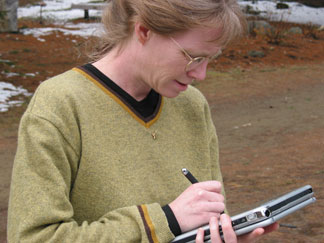GEOG/GEOL 355
 Taught by: Mary Ann Cunningham
Taught by: Mary Ann Cunningham
The Course
What is your course “Environment and Land Use Planning” about?
In Environment and Land Use Planning I try to give students an opportunity to work on real problems of land use and planning in Poughkeepsie and the surrounding area. Poughkeepsie is located in historically agrarian Dutchess County and also at the end of the New York City commuter rail line. Thus we are situated in an area of rapid urban expansion, which results in constant turmoil about land use policy in municipal and county governments. Local governments exhibit a mixture of enlightened, forward-thinking planning ideas and short-sighted enthusiasm for inefficient and unplanned growth. Local problems, then, provide rich opportunities to consider new and old ideas about how, and how much, planning should be done to conserve a livable environment.
The Technology
How does this particular software tool enhance your teaching goals? Why is it better than other technologies or artistic techniques?
Any question of land use involves mapping. Although most students in this class have no experience with computer mapping, I give everybody at least one exercise with GIS (geographic information systems, computer mapping and analysis). About one-third of the students have subsequently chosen to include GIS mapping as part of their analysis. They do so because they’re intrigued by the maps and data, because they know it’s useful to learn the software, and because they begin asking questions whose answers require spatial analysis.
GIS gets a lot of attention for two reasons. It allows us to make maps (and who doesn’t love maps?) and it provides analytical tools for spatial analysis and modelling, which give insights into spatial relationships and patterns that are otherwise hard to detect.
Learning all the tools of GIS takes years, but students can pick up a lot of the basics quickly if they’re willing to be adventurous and explore the software. Once they’ve figured out how to navigate the data and control the display, the GIS can be very empowering. It helps students understand the shape of their problem and the variables involved.
Another advantage of GIS is that it enhances multi-disciplinary learning. When we examine simultaneously physical features, such as soils, geology, watershed, and floodplains, and social and cultural factors, such as income distribution, population density, or transport networks, the inextricable relationships among them become quite clear. I think GIS facilitates multi-disciplinary analysis.
The Student Response
How have your students responded to your use of technology?
Students are initially delighted to explore the maps and data, then they become frustrated when the software doesn’t behave as they expect. After a little more experience, most quickly start experimenting with new utilities, probing farther and farther into the tools available. I like to watch new users becoming independent and finding their own answers. Students also gain a satisfying appreciation of how maps are made, how Google Earth might work, and what sort of infrastructure is involved in producing the abundant data we take for granted.
The Challenges
What are the challenges you faced teaching this class for the very first time?
Software can take a lot of time. So do field trips, discussing readings, and all the other experiences of a course. I love to see the students take on GIS components in their Environment and Land Use Planning projects, but we also have to negotiate time budgets and ensure that they have enough time to just sit and think about the problem they’re studying, as well as learning the technology.
New Directions
Are there any new directions you would like to explore next Spring, other new things you would like to try out?
As more students come to this class with some background in GIS, I look forward to increasingly sophisticated projects. I can imagine that in the coming years we’ll be doing more analysis and more modelling. I also hope to see increasingly critical use of the software– uses that develop critiques of policies and assumptions we all share. Data availability also makes a critical difference. In the past ten years the amount and quality of GIS data has mushroomed. I can barely imagine what the state of data will be like ten years from now; I’m sure it will be interesting.
